Green cleaning services play a vital role in the Healthy Schools Campaign by eliminating toxic cleaning chemicals and volatile organic compounds (VOCs) that have been proven to negatively impact student performance.
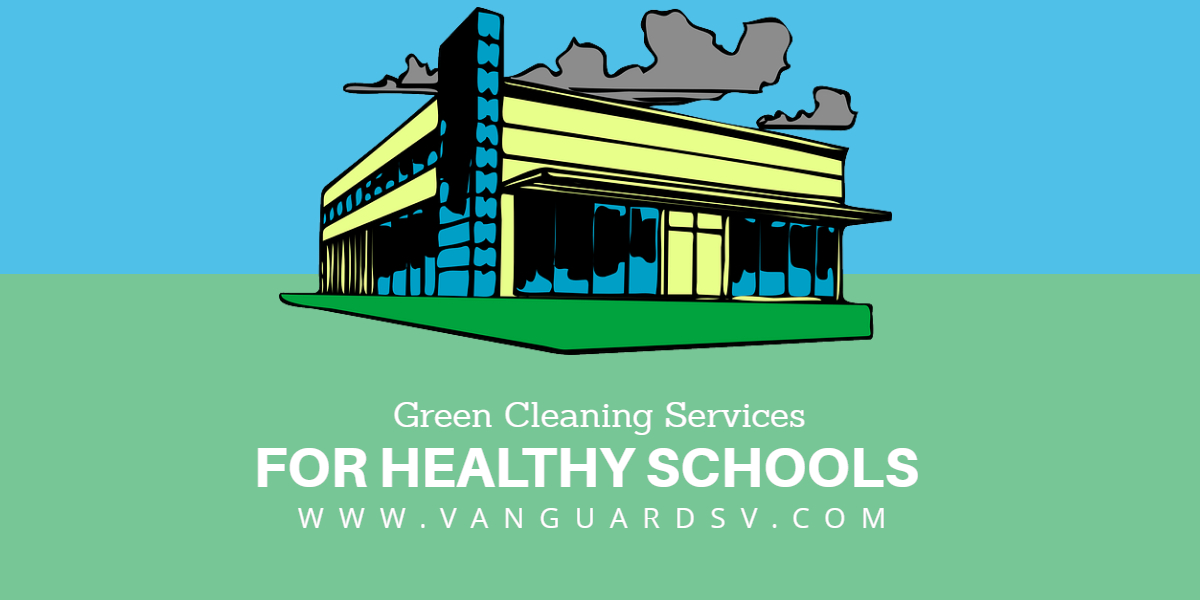
Green Cleaning Services for Healthy Schools Campaign's
Student absenteeism has reached epidemic proportions.
According to the American Federation of Teachers (AFT), studies estimate;
[sic]...a national rate of 10 percent chronic absenteeism, though researchers suspect the rate is more likely around 15 percent.
That's 5 million to 7.5 million students who are absent from 18 to 20 days of the school year.
Those statistics have been substantiated by further studies which researched the correlation between the spread of infectious disease and student and teacher absenteeism.
According to the National Academies Press;
For children attending public schools, the transmission of common infectious diseases is estimated to result in more than 164 million lost school days each year...[sic].
On average, students are absent from school 4.5 days per year, and teachers miss work 5.3 days each year because of acute illness...[sic]
When surveyed, more than 80 percent of teachers cited school absenteeism as their main problem...[sic]
7 Building Characteristics and the Spread of Infectious Diseases
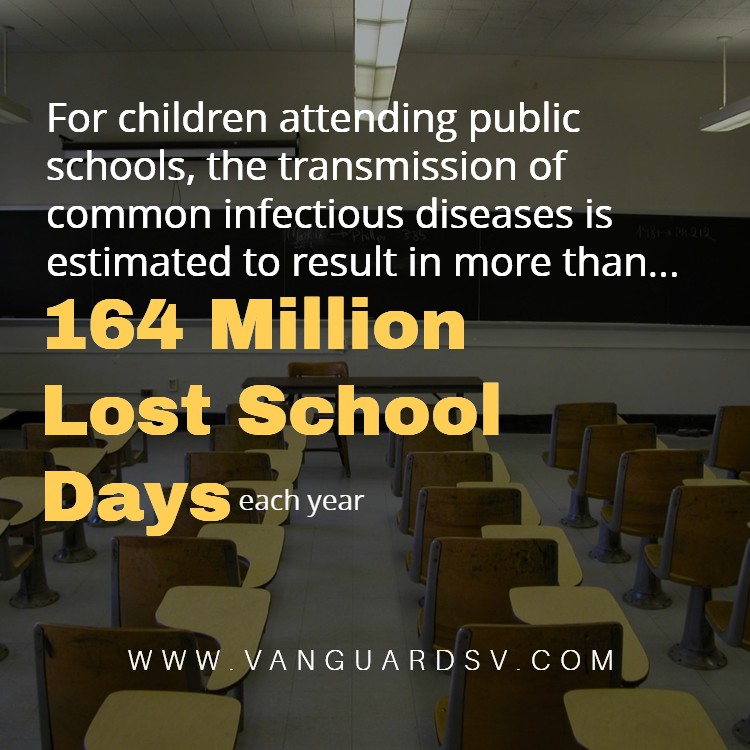
Green cleaning services and chemicals can eliminate common environmental factors and practices that contribute to poor student health; the leading preventable cause of student and faculty absences.
Green Cleaning Services and Infection Prevention in Schools
According to the Green Clean Schools Healthy Schools Campaign, there are three fundamental concepts that districts must adopt to ensure the health and safety of their staff and students.
- Hygiene Education.
- A thorough green cleaning program, and;
- Cleaning with the right equipment and procedures.
Hygiene Education
Students, faculty, and school nurses should be regularly trained and reminded about the importance of proper hand washing and to cover one's mouth or nose when coughing or sneezing.
A rigorous scrubbing with regular, not antibiotic/antibacterial soap and warm water are recommended for 30 seconds before eating, or after coughing or sneezing.
Alternatively, alcohol-based liquid hand sanitizer can be employed when soap is not available, but should not be used as a permanent substitute.
See Also:
- How to Teach Children to Wash Their Hands
- FDA Bans Antibacterial Soap
- Cleaning Services Questions: How Dirty is a Bar of Soap?
Green Cleaning Program
The toxicity of conventional cleaning chemicals requires safe handling, storage, application, and cleanup, primarily when used to sanitize or disinfect surfaces that young children, who are prone to placing their hands in their mouth, may come into contact with.
Conscientious product purchasing and label reviews are necessary to ensure chemicals used in the cleaning process cannot contribute to illness, or trigger asthma or allergic reactions that negatively impact attendance and performance.
Additionally, chlorine bleach, one of the most commonly employed disinfectants in schools, is highly corrosive, is not absolutely biodegradable, may be manufactured with mercury, and its fumes have been linked to short and long-term respiratory health problems.
The safer and healthier approach is to partner with a green cleaning provider capable of supplying Green Seal certified solvents and chemicals that have been proven environmentally safe, as well as efficient chemical management systems that accurately dilute cleaning chemicals with the appropriate volume of water to avoid waste and unnecessary labor to go back over an inadequately sanitized surface.
See Also:
Equipment & Procedures
Using the correct chemicals for the prescribed task while avoiding adding additional toxins to the local environment, especially the air is only half the challenge.
A district dedicated to a Healthy Schools Campaign must also acquire the proper tools for the job, as well as institute correct procedures to avoid cross-contamination.
An example of this would be color-coded microfiber cloths and mops that are used in a specific room or on a particular surface, combined with a two-bucket system for clean and dirty water.
Of vital importance is chemical laytime, whereby a sanitizer or disinfectant must remain, undisturbed, on a surface for a specified amount of time to achieve full effectiveness.
After that time frame has expired, the custodial staff will then need to ensure that no film remains behind to avoid potentially problematic ingestion from children via surface-to-skin-to-mouth contact.
Proper ventilation is also required, even with environmentally safe cleaners, to avoid respiratory inflammation.
See Also:
A Note on Volatile Organic Compounds
A fundamental factor directly tied to student and faculty health and performance is indoor air quality, which can be negatively impacted by the off-gassing of volatile organic compounds (VOCs) from multiple sources, including chemical cleaners and solvents.
According to the U.S. Environmental Protection Agency (EPA);
[sic]...Insufficient cleaning or excessive use of cleaning chemicals...[sic]...can trigger a host of health problems — including asthma and allergies — that increase absenteeism and reduce academic performance.
Research links key environmental factors to health outcomes and students’ ability to perform.
How Does Indoor Air Quality Impact Student Health and Academic Performance?
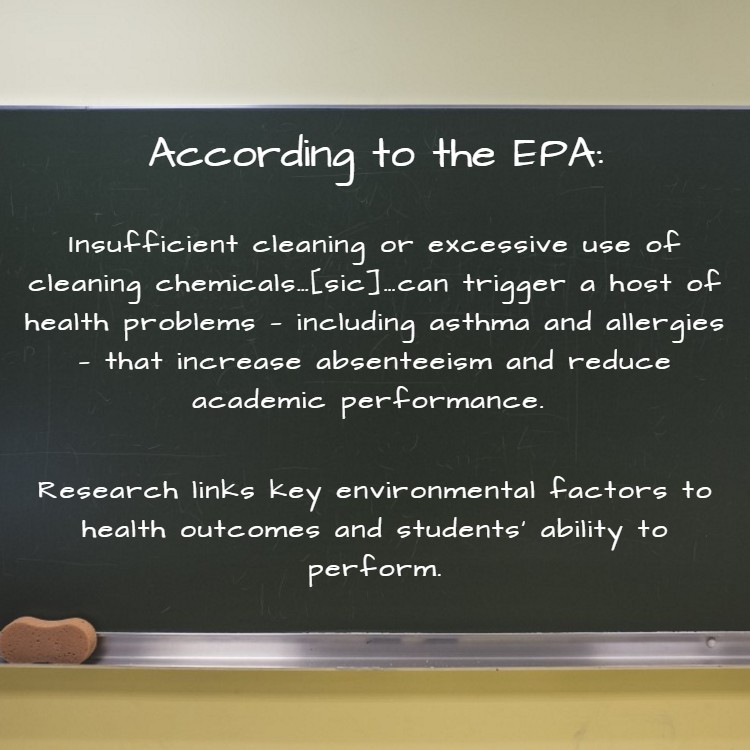
VOCs can off-gas from any number of items, including carpet, groundwater, as well as cleaning chemicals.
According to Greenguard Certification;
[sic]...the very products and processes that are used to keep indoor environments clean also may contribute to indoor pollution...[sic].
In many cases, volatile organic compounds (VOCs) emissions from cleaning products are the primary cause of concern.
In response, the cleaning industry has made significant strides in its commitment to create and responsibly use and depose of cleaning products to protect both the indoor and outdoor environments.
Cleaning Products & Processes: Partnering for Healthier Indoor Environments
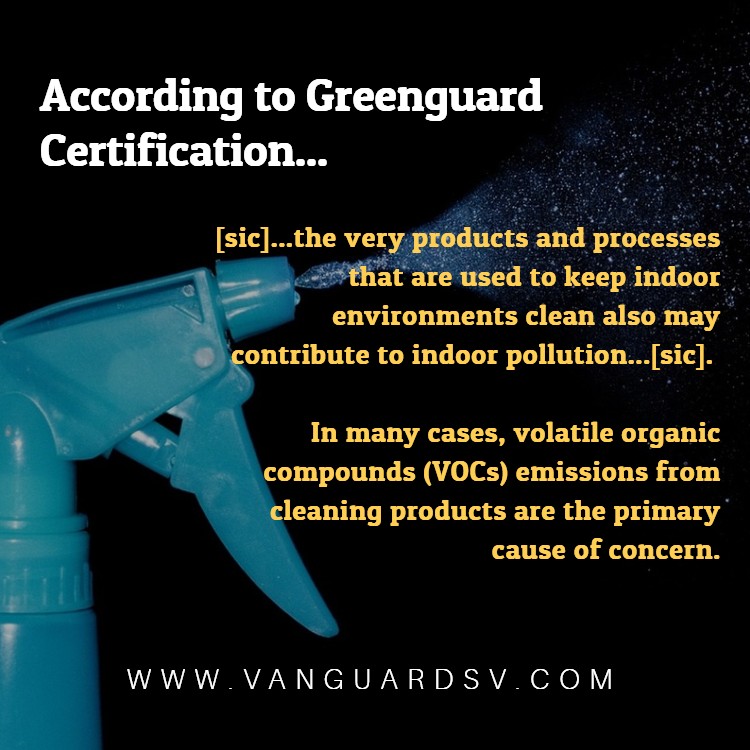
Green Cleaning Tips
- Ensure students and faculty are exposed to enough fresh air and sunshine, especially in the classroom.
- Avoid using commercial chemical cleaners to clean, sanitize, or disinfect indoor surfaces to eliminate the off-gassing of toxic chemicals into the indoor environment, and negatively impact the health and performance of the building occupants.
- Ensure the proper tools and products are used correctly, and that all staff and students are trained in appropriate emergency contact and response procedures.
- Implement chemical management systems to avoid resource waste.
- Adhere to OSHA, CDC, and EPA cleanliness requirements for nurses offices.
- Follow color-coded tool procedures to avoid cross-contamination between rooms and surfaces.
References & Resources
- Infection Control
- Healthy Schools Campaign - Resource Center
- Quick Reference Guide about Student Health and Academic Performance
Takeaway
With rising student and faculty absenteeism attributed to the preventable transfer of illness, school districts must take immediate action to ensure the health and safety of its workforce, as well as the prospective future of its students.
Professional green cleaning services can provide your schools with a significant advantage by safely eliminating the use of toxic chemicals while providing a more cost-effective level of disinfection and sanitation in classrooms, and business and nursing offices.
If you would like to learn more about the advantages of green cleaning services for your school or business, contact us today for a free quote!
In Bakersfield CA, call (661) 395-3009
In Fresno CA, call (559) 473-1790

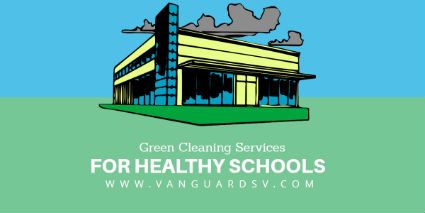
You must be logged in to post a comment.